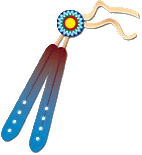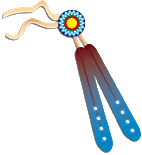

| The Talking Stick |
| The Talking Stick Carol Locust, Ph.D. Native American Research and Training Center Tucson, Arizona (Tribal affiliation -- Eastern Band Cherokee) The talking stick has been used for centuries by many American Indian tribes as a means of just and impartial hearing. The talking stick was commonly used in council circles to designate who had the right to speak. When matters of great concern came before the council, the leading elder would hold the talking stick and begin the discussion. When he finished what he had to say he would hold out the talking stick, and whoever wished to speak after him would take it. In this manner the stick was passed from one individual to another until all who wished to speak had done so. The stick was then passed back to the leading elder for safe keeping. Some tribes used a talking feather instead of a talking stick. Other tribes might have a peace pipe, a wampum belt, a sacred shell, or some other object by which they designate the right to speak. Whatever the object, it carries respect for free speech and assures the speaker he has the freedom and power to say what is in his heart without fear of reprisal or humiliation. Whoever holds the talking stick has within his hands the sacred power of words. Only he can speak while he holds the stick; the other council members must remain silent. The eagle feather tied to the talking stick gives him the courage and wisdom to speak truthfully and wisely. The rabbit fur on the end of the stick reminds him that his words must come from his heart and that they must be soft and warm. The blue stone will remind him that the Great Spirit hears the message of his heart as well as the words he speaks. The shell, iridescent and ever changing, reminds him that all creation changes -- the days, the seasons, the years -- and people and situations change, too. The four colors of beads -- yellow for the sunrise (east), red for the sunset (west), white for the snow (north) and green for the earth (south) -- are symbolic of the powers of the universe he has in his hands at the moment to speak what is in his heart. Attached to the stick are strands of hair from the great buffalo. He who speaks may do so with the power and strength of this great animal. The speaker should not forget that he carries within himself a sacred spark of the Great Spirit, and therefore he is also sacred. If he feels he cannot honor the talking stick with his words, he should refrain from speaking so he will not dishonor himself. When he is again in control of his words, the stick will be returned to him. This article is a handout sheet used in workshops, and is included here with the permission of its author. The drawing is of the talking stick which Dr. Locust uses in her workshops. Requests for more information about the Talking Stick will be forwarded to Dr. Carol Locust. Please send requests to comments@acaciart.com . © 1997 - 2004 Acacia Artisans® |
| Talking Sticks are one of my favorite wedding gifts to give a couple... The story of the Talking Stick is below. After reading it, I'm sure you will see why it is such a wonderful gift to give a couple just starting out.... Please know that it is illegal for anyone who is not a carded Indian to have an Eagle feather, so the Talking Stick you purchase will not have one. Buffalo hair is sometimes hard to come by as well. I will do my best to make your Talking Stick one that you will be proud to own and follow tradition as best I can... |



